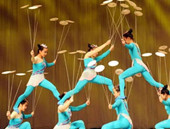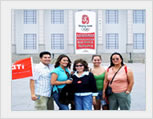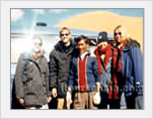
Acrobatics
 The Chinese acrobatics has a long history and rich national flavor. It is the general name of all sorts of extraordinary stunts. During the comprehensive development of original art, acrobatics combined with music and dance. It was the leading trend of culture at the time. It is one of the most popular art forms among the Chinese people. As early as the Warring States Period (475-221BC), acrobatics appeared. In Qin Dynasty (221 – 206 BC) it was introduced into the court. By the time of Han Dynasty (206 BC – 220 AD), the acrobatic art or “Hundred Plays” further development both in contents and varieties. There were performances with music accompaniment on the acrobatic stage of two thousand years ago, such as “Pole Climbing”, Walking on Rope (the present-day tight-wire feat), “Fish Turned into Dragon” (the present-day “Conjuring”), and “Five Tables” (like the present-day “Balance on Chairs”).
The Chinese acrobatics has a long history and rich national flavor. It is the general name of all sorts of extraordinary stunts. During the comprehensive development of original art, acrobatics combined with music and dance. It was the leading trend of culture at the time. It is one of the most popular art forms among the Chinese people. As early as the Warring States Period (475-221BC), acrobatics appeared. In Qin Dynasty (221 – 206 BC) it was introduced into the court. By the time of Han Dynasty (206 BC – 220 AD), the acrobatic art or “Hundred Plays” further development both in contents and varieties. There were performances with music accompaniment on the acrobatic stage of two thousand years ago, such as “Pole Climbing”, Walking on Rope (the present-day tight-wire feat), “Fish Turned into Dragon” (the present-day “Conjuring”), and “Five Tables” (like the present-day “Balance on Chairs”).
 In the Tang Dynasty (618 -907 AD), the most thriving period, the number of acrobats greatly increased and their performing skills much improved. It was popular both in the court and among the folk. Acrobatic performances were showed not only on the royal family banquets, but also given at the procession march of the countries. In the Dunhuang mural painting “Lady Song Going on a Journey”, there are images of acrobatic and circus performers. In Tang Dynasty, some of the items of “Hundred Plays” were eliminated, and the shows were not as grand as before. On the other hand, more new and unprecedented stunts appeared. After Song and Yuan dynasties (10 – 14 century AD), along with the negligence of the classical dances, acrobatics were demoted to the bottom of the society. The Performing style and contents were changed a great deal. The grand performances vanished; most of the repertories became the means of living of the folk artists. The various mini items were developed for one family or one person to perform. Some previous matchless master pieces of stunts were inherited and handed down from generation to generation.
In the Tang Dynasty (618 -907 AD), the most thriving period, the number of acrobats greatly increased and their performing skills much improved. It was popular both in the court and among the folk. Acrobatic performances were showed not only on the royal family banquets, but also given at the procession march of the countries. In the Dunhuang mural painting “Lady Song Going on a Journey”, there are images of acrobatic and circus performers. In Tang Dynasty, some of the items of “Hundred Plays” were eliminated, and the shows were not as grand as before. On the other hand, more new and unprecedented stunts appeared. After Song and Yuan dynasties (10 – 14 century AD), along with the negligence of the classical dances, acrobatics were demoted to the bottom of the society. The Performing style and contents were changed a great deal. The grand performances vanished; most of the repertories became the means of living of the folk artists. The various mini items were developed for one family or one person to perform. Some previous matchless master pieces of stunts were inherited and handed down from generation to generation.
 In Ming & Qing dynasties, (1368 -1911 AD), acrobatic shows were still declining. Performances by one person, father and son, master and apprentice were further developed. Many old techniques of acrobatics were retained, so various serious of mini-performances came into being. Some of the special stunts appearing during Yuan and Ming dynasties were absorbed into some local operas, for example, “Balance on Chairs” of Pu Opera, “Changing Face” and “pouring out fire from the mouth” were all introduced from the acrobatics. The acrobatic art was spread to overseas and won praise in Europe and America in the late Qing and early years of Republic. The characteristics of Chinese acrobatic are embody super skill, magic performance, difficult technique and dangerous stunts. All of them present the unique charm of Chinese acrobats. In recent years, the acrobats of China have won many awards in international competitions. China is considered as “the number one country of acrobatics” in the world.
In Ming & Qing dynasties, (1368 -1911 AD), acrobatic shows were still declining. Performances by one person, father and son, master and apprentice were further developed. Many old techniques of acrobatics were retained, so various serious of mini-performances came into being. Some of the special stunts appearing during Yuan and Ming dynasties were absorbed into some local operas, for example, “Balance on Chairs” of Pu Opera, “Changing Face” and “pouring out fire from the mouth” were all introduced from the acrobatics. The acrobatic art was spread to overseas and won praise in Europe and America in the late Qing and early years of Republic. The characteristics of Chinese acrobatic are embody super skill, magic performance, difficult technique and dangerous stunts. All of them present the unique charm of Chinese acrobats. In recent years, the acrobats of China have won many awards in international competitions. China is considered as “the number one country of acrobatics” in the world.
Your Question & Quick Answer*We welcome and appreciate your questions & reviews
Booking Procedures | Terms & Conditions | Payment Methods | Links | Site Map | About Us | Contact Us | Travel Agent
Copyright 2008, All rights reserved.. itourbeijing.com ,china culture, china introduction
TEL: 86-10-85711972 (Universal) 1-888-288-9328 (North America) E-mail: contact@itourbeijng.com
Home | China Tours | Beijing Tours | Tibet Tours | China Travel | Beijing Travel | Shanghai Travel



